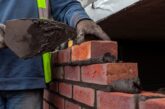
Sandra Higginson, technical advisor at Tarmac Cement, discusses the positive implications for using concrete in landscaping projects.
Modern and visually appealing, with qualities of strength, durability and affordability, concrete is seeing a new wave of usage and innovation in outdoor spaces. In fact, a recent 2018 report by WGSN highlighted that concrete is trending across trade shows and particularly with emerging designers.
Innovation in moulding and setting techniques have boosted its versatility, with many using the material in unexpected and unusual ways, especially for landscaping projects. The hard-wearing material blends well with surrounding nature while many different types of concrete can be applied in a variety of finishes to suit an array of shapes, styles and designs.
The concrete craze
Updating or re-designing the garden for summer can be an exciting prospect for your customers, and incorporating concrete into the landscape could be the answer to creating a modern, attractive and practical space.
From brick barbeques and patios, to board-formed concrete walls and worktops, concrete can transform garden areas into an outdoor oasis, while also offering excellent functional benefits.
Importantly, concrete is relatively inexpensive, and it can endure extreme weather without cracking and scratching, as well as provide strong resistance against moisture, mould or pests.
Board marked concrete
Using poured high strength concrete for exterior walls can give your customers one of the most enduring, fire-resistant, thermally retentive and maintenance-free solutions. A concrete wall can last without decay for many years, protecting both the reputation and standards of your work.
Importantly for design, concrete takes on the shape and texture of the forms into which it is poured, making it possible to enrich its surface character by using textured forms. Often, timber is used in combination with concrete walls to add warmth to the overall composition. For example, if the concrete has been formed with horizontal, rough-board forms, the concrete’s surface is imprinted with wooden texture and the two materials work well to create a stylish looking wall for any outdoor area.
Outdoor kitchens
As the trend for outdoor kitchens and entertaining at home gains traction, landscapers and builders are beginning to explore the different ways they can add value to their customers’ alfresco aspirations.
Installing a concrete worktop is a sure-fire way to infuse a stylish aesthetic in to your client’s garden. The worktop doesn’t need to appear cold or industrial, concrete can complement almost any style of garden, the key is to suggest adding other warmer, natural textures like fabric or wood to keep it from feeling too austere.
Adding inserts or inlays is a great way to personalise a concrete workstation. Whether its small stones, pieces of glass or other materials that are mixed throughout the concrete, these can all contribute to a stylish and liveable outdoor landscape.
However, as concrete worktops are generally long, slender, thin beams, it’s critical to use a product with adequate workability and flexural strength such as Tarmac Blue Circle High Strength concrete (40N) to prevent cracking, chipping and shrinkage.
![]()
The brick BBQ
The classic brick BBQ is a firm favourite in the summertime, yet it doesn’t need to come with a hefty price tag. Simple to build and use, a brick BBQ can be an attractive addition to any patio area, without the added worry of rusting or breakage to metals.
Simply build a solid foundation, mark out the brickwork area and prepare a mortar to lay the bricks. Using a pre-bagged, ready to use mortar mix such as Tarmac Blue Circle Quality Assured Mortar, simplifies the task even further, requiring only the addition of clean water.
Additional jobs
Of course, not all landscaping projects are determined by the bigger jobs. Something as simple as checking for unstable fence posts or empty joints between paving slabs can keep a garden in shape during summer.
For unbalanced fence posts, use a quick setting, no mix concrete product, such as Tarmac Blue Circle Postcrete. Bury the post below the ground, then simply fill the hole one third with clean water and pour in the Postcrete evenly around the post until dry powder is visible on the surface. The Postcrete will set in as little as 10 minutes.
Pointing between patio slabs should also be checked and repaired where necessary. A pre-mixed bagged mortar is suitable as it possesses strong weather resistance and durability. Highly workable and cohesive, with a long board life, mortar can enhance the appearance and longevity of paving areas.
Clearly, the creative possibilities of concrete are expanding, and builders have the opportunity to use concrete in original and inventive ways. Yet, whether it’s a glamorous alfresco job or routine garden maintenance, using the right cement and concrete products can be crucial to maintaining a functional outdoor space.
![]()







